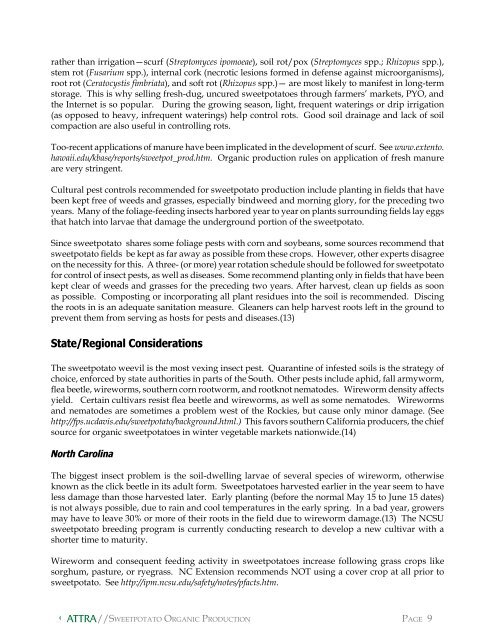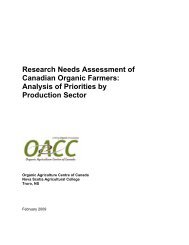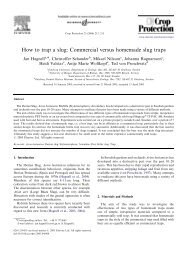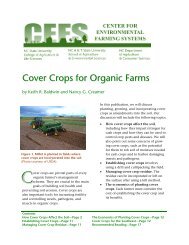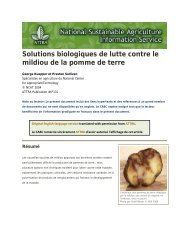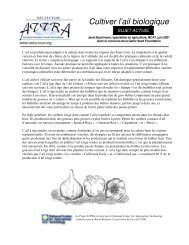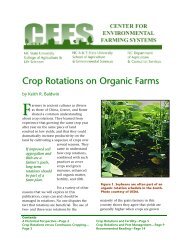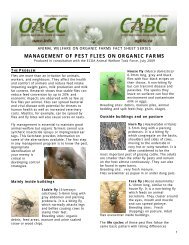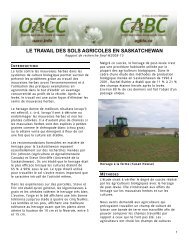Sweet potato: organic production - Centre d'agriculture biologique ...
Sweet potato: organic production - Centre d'agriculture biologique ...
Sweet potato: organic production - Centre d'agriculture biologique ...
Create successful ePaper yourself
Turn your PDF publications into a flip-book with our unique Google optimized e-Paper software.
ather than irrigation—scurf (Streptomyces ipomoeae), soil rot/pox (Streptomyces spp.; Rhizopus spp.),stem rot (Fusarium spp.), internal cork (necrotic lesions formed in defense against microorganisms),root rot (Ceratocystis fimbriata), and soft rot (Rhizopus spp.)— are most likely to manifest in long-termstorage. This is why selling fresh-dug, uncured sweet<strong>potato</strong>es through farmers’ markets, PYO, andthe Internet is so popular. During the growing season, light, frequent waterings or drip irrigation(as opposed to heavy, infrequent waterings) help control rots. Good soil drainage and lack of soilcompaction are also useful in controlling rots.Too-recent applications of manure have been implicated in the development of scurf. See www.extento.hawaii.edu/kbase/reports/sweetpot_prod.htm. Organic <strong>production</strong> rules on application of fresh manureare very stringent.Cultural pest controls recommended for sweet<strong>potato</strong> <strong>production</strong> include planting in fields that havebeen kept free of weeds and grasses, especially bindweed and morning glory, for the preceding twoyears. Many of the foliage-feeding insects harbored year to year on plants surrounding fields lay eggsthat hatch into larvae that damage the underground portion of the sweet<strong>potato</strong>.Since sweet<strong>potato</strong> shares some foliage pests with corn and soybeans, some sources recommend thatsweet<strong>potato</strong> fields be kept as far away as possible from these crops. However, other experts disagreeon the necessity for this. A three- (or more) year rotation schedule should be followed for sweet<strong>potato</strong>for control of insect pests, as well as diseases. Some recommend planting only in fields that have beenkept clear of weeds and grasses for the preceding two years. After harvest, clean up fields as soonas possible. Composting or incorporating all plant residues into the soil is recommended. Discingthe roots in is an adequate sanitation measure. Gleaners can help harvest roots left in the ground toprevent them from serving as hosts for pests and diseases.(13)State/Regional ConsiderationsThe sweet<strong>potato</strong> weevil is the most vexing insect pest. Quarantine of infested soils is the strategy ofchoice, enforced by state authorities in parts of the South. Other pests include aphid, fall armyworm,flea beetle, wireworms, southern corn rootworm, and rootknot nematodes. Wireworm density affectsyield. Certain cultivars resist flea beetle and wireworms, as well as some nematodes. Wirewormsand nematodes are sometimes a problem west of the Rockies, but cause only minor damage. (Seehttp://fps.ucdavis.edu/sweet<strong>potato</strong>/background.html.) This favors southern California producers, the chiefsource for <strong>organic</strong> sweet<strong>potato</strong>es in winter vegetable markets nationwide.(14)North CarolinaThe biggest insect problem is the soil-dwelling larvae of several species of wireworm, otherwiseknown as the click beetle in its adult form. <strong>Sweet</strong><strong>potato</strong>es harvested earlier in the year seem to haveless damage than those harvested later. Early planting (before the normal May 15 to June 15 dates)is not always possible, due to rain and cool temperatures in the early spring. In a bad year, growersmay have to leave 30% or more of their roots in the field due to wireworm damage.(13) The NCSUsweet<strong>potato</strong> breeding program is currently conducting research to develop a new cultivar with ashorter time to maturity.Wireworm and consequent feeding activity in sweet<strong>potato</strong>es increase following grass crops likesorghum, pasture, or ryegrass. NC Extension recommends NOT using a cover crop at all prior tosweet<strong>potato</strong>. See http://ipm.ncsu.edu/safety/notes/pfacts.htm.ATTRA//SWEETPOTATO ORGANIC PRODUCTION PAGE 9


